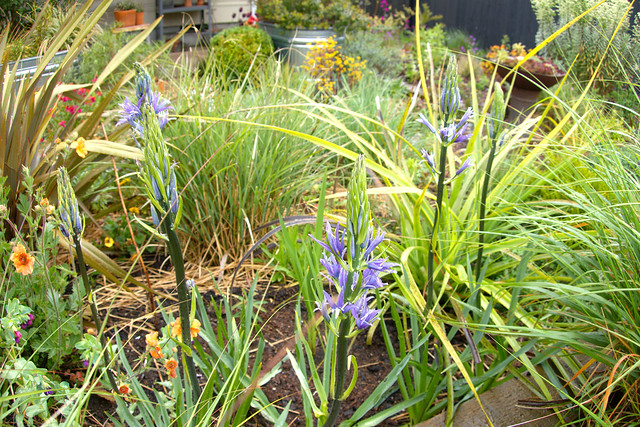This last Sunday of April has been misty and rainy, the same conditions since mid-week. Until the rains returned last Wednesday, I personally felt we had gone too long without rain (almost a week). But I know the farmers were becoming nervous about getting a second cut of grass done and felt pushed off schedule by the still-soggy ground, so they welcomed the dry spell to get some field work done. Funny how the neighborhood follows the farmers’ grass-cutting schedule, with small lawns appearing neatly mown seemingly overnight. We took the hint and pushed a mower over the tiny patch of shaggy grass at the front of the house. I’ve been slowly planting up the front north-facing garden, using divisions and castoffs from the back garden, where all my primary attention has been directed. Nothing much to show in the front garden yet, but we are working on a fence for Billie, Hannah and Domino, who just started walking around her first birthday.
Planting anything for the first time is always fraught with misgivings. Yet the five bulbs of Camassia leichtlini planted last fall seemed to know exactly what to do. They are after all native to western North America and thrive in moist meadows, and a moist meadow pretty much describes my back garden for eight months of the year. When the flowers began to open last week, I realized my only mistake was not planting more. I called around Portland nurseries to check if any potted bulbs were available, found a source, and took a rainy drive east to bring home two more bulbs planted in gallons. (This fall I will be ordering more bulbs, the easiest and most affordable way to go.)
The only uncertainty remaining is how the dying foliage interacts with expanding spring and summer growth of surrounding plants. Judging by last summer, there’s no question the dying foliage will be concealed, the only question being will the leaves get enough sun for the health of the bulb.
What else is stirring? Asphodels! Asphodeline lutea. Out of three clumps, all different sources, one is in bloom, another clump showing three buds. The only unsuccessful clump was mail-ordered, ‘Italian Gold.’ The latter’s leaves have died off and one flower spike withered before bloom. The thriving clumps were both grown locally. Makes sense to me.
The euphorbias continue to be a dominant presence in April as they have been all year. I can’t imagine spring without them…or more camassias!















I had to laugh when I read that you’d become concerned when you went nearly a week without rain, Denise. How quickly you’ve adapted to your new climate! All indications are that SoCal’s rainy season is over, although NorCal and the mountain/hillside areas of SoCal may get a bit more through May. Camassia is yet another plant I’ve wanted to grow but of course it’s not happy here. Growing all those “new” plants in your Oregon location must be fun.
I think I’m the only PNW hardcore gardener that doesn’t grow camassia! I think they’re lovely though, and it’s nice to see that you’ve fallen under the spell too. I miss my Asphodeline lutea which did great for awhile then they just faded away. As for that Cirsium rivulare, nice work! I grew that for years in a nice sunny spot and it never did flower.
So what’s this about a 1 yr old? Did I miss that you have another grandchild?
The Camassia leichtlini is so lovely. I think a spot of shade won’t do it harm. I recently saw some in its natural habitat on the margins of oak woodland with open meadow. The foliage will die quickly and you’ll never know it was there. We have that and also the Asphodel at Cistus where I work, by the way but yes, buying bulbs online is the way to go. And also, your garden is looking amazing! And also….so excited you’ll be going to the Fling this year! Cheers.
@Kris, I’m still nervous over a stretch without rain…even in a rain forest! Glad I made you smile 😉
@Loree, Mitch and his partner had little Domino a year ago in April.
@Tamara, must be amazing to see camassia en masse. I do see fields of skunk cabbage on the coast but not camassia. Yes, so excited for the Fling this year, yay!
They are lovely plants. A whole new palette to work with in a different climate. Gardening is a huge subject no wonder we never get bored.
Camassias are really great Spring plants. I have quite a few in my garden even though it is significantly colder than yours. I find the foliage takes a long time to die back, staying green until the temperatures get really hot so you don’t tend to notice it as other things have popped up around it.
If you let your camas go to seed, you will soon have an abundance. I find them to be very, very prolific. And, they definitely don’t seem to be harmed by having their leaves shaded. Mine disappear under a mass of waterleaf (Hydrophyllum) and shiny geranium weeds, yet still manage to bloom themselves silly in a morning sun border. Your Cassinia x ozothamnus hybrid is a real beauty.
@Hoov, so many great plants…
@Elaine, thanks for the input on the post-bloom period. I’ve read to keep them out of the borders, being fit only for long grass and meadows. But my borders get fairly rambunctious with big plants, so I think it should work 😉
@Jerry, that would be amazing if they self-sowed, even if it takes a bit of time to grow to blooming size. I’ve been shocked by prolific self-sowers already, like dierama! Comes up like grass…
Jerry, about going to seed, I just read Dig Delve/Dan Pearson on cammasias and he confirms how weedy it can become, so I cut off the seedheads. I’ve got some cuttings going on that cassinia cross and will keep you posted 😉